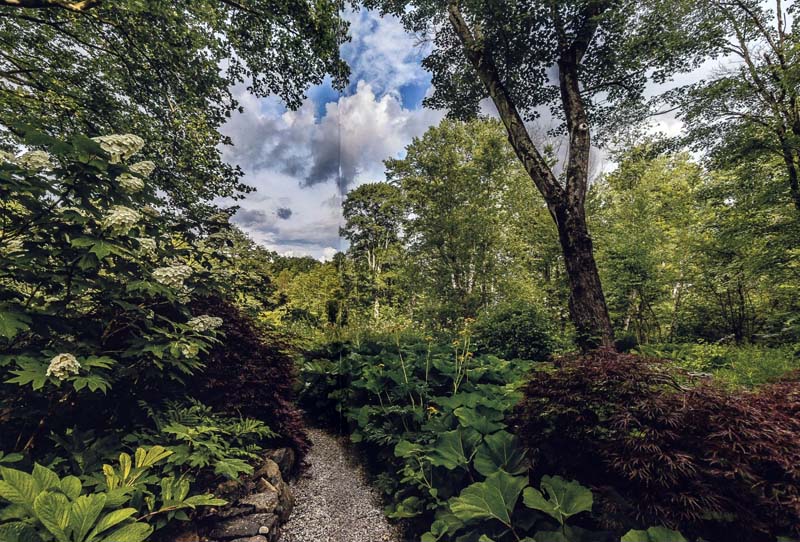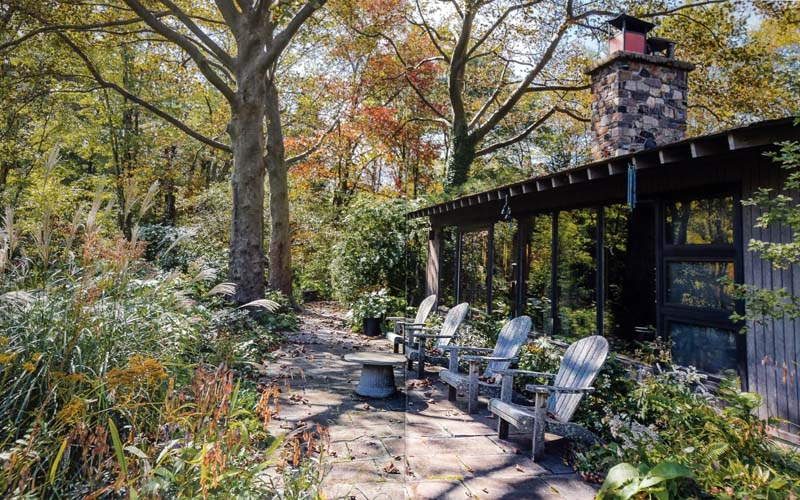The View from Federal Twist
This is the story of a gardener and a garden growing and developing together to create a modern American horticultural masterpiece. James Golden was approaching retirement when he purchased a property in western New Jersey, USA, because the house “suited its setting” and “had an intimate relationship with the place”. He had immediately sensed the spirit of this property, a house set in a woodland clearing, and every addition and change he made afterwards was ecologically appropriate – everything he did “suited its setting.”

Had James Golden consulted a landscape architect or a garden designer when he had his first thoughts of starting a garden at Federal Twist, a site of heavy muddy soil, permanently wet, with a thriving population of marestail, I believe he would have been advised to move, to search out a property more suited to gardening, one less challenging and less demanding. Or he might have been advised to bring in heavy machinery to install an efficient land-drainage system with a sculpting of the land to make it easier to work and enjoy. James Golden did none of the above but ploughed ahead in the style one might describe as either absolutely foolhardy or pure genius. The results say it was pure inspired genius.
The garden developed along the lines of the traditional American garden common in the 18th and 19th centuries, “a clearing in the woods”, a garden style still popular today where the gardener works within the setting, works with the woodland, accepting its benefits and constraints, allowing the land to dictate and not imposing more than necessary on it – truly an ecological garden. He began by clearing seventy trees, Eastern Red Cedar, and the under scrub to create his clearing in the wood.
His first planting was of Filipendula rubra ‘Venusta’ – with the appropriate common name of “Queen of the Prairie” – and, this is where the “normal” gardener squirms and screams “Oh, no! How could he?” for he simply planted a large number of these into and among the plants, the native wild plants, which were already on site. He was given “neglected woods, weeds, heavy clay and too much water” and created a garden that was “informal, naturalistic, ecological…a bit chaotic”. He accepted what already existed and set out “simply to help it be a better version of itself” for this would be the key to making a garden which would feel “right” in its place. Everything which was added was chosen to fit – pathways were informal and meandering; walls were of local stone; plants were what would suit the situation and the conditions; there was no imposition of “garden features”. There are no lawns, no flower beds, nothing utilitarian; it is a naturalistic garden, a landscape garden which fits into its landscape with a planting to suit the ecology of the place. The garden is still changing and developing as the author deals with challenges, opportunities and new ideas – as all woodland gardens are in a state of constant change. It is a garden in movement.
I imagine James Golden as a man who dreams of gardens, of gardening, who reads extensively and plans imaginatively and with vision, a dreamer, a man with hope, an experimenter, a chancer, a having-fun-with-gardening man, a taker of chances and a hoping for the best man, a try it and see man, a man having great fun with his gardening. He acknowledges his wide reading on garden, his visits to many gardens, and those who have influenced him and, though there were others, it is the approach of Gilles Clement which is closest to his heart, a man who saw gardening not as an act of dominating, of imposing one’s power on the land but the very opposite, of dealing with what is living on the ground and to go in the direction of the energies of the place and not against.
The View from Federal Twist has, in a sense, been written over many years for this is also the title of a blog which James Golden has written over his years of creating the garden where he told of his dreams, his plans, his failures and successes, his daily gardening and his thoughts, feelings and experiences. The book is then, in a sense, a review, a mature reflection by the author on his own development as a gardener as well as on the creation of his garden. While the practicalities of the gardening at Federal Twist are all very well described and illustrated, it was the background thought and philosophy which most gripped me and which I found most interesting.
Federal Twist, a house and garden in a clearing in the woods, is, in a simple sense, a classic, archetypal American garden but James Golden has lifted the classic to levels not previously imagined and has shown the way forward for gardeners who wish to create an ecological garden in tune with the environment. We have a modern garden classis!
[The View from Federal Twist, A New Way of Thinking about Gardens, Nature and Ourselves, James Golden, Filbert Press, 2021, Hardback, 240 pages, £40, ISBN: 978-1-9997345-7-2]




